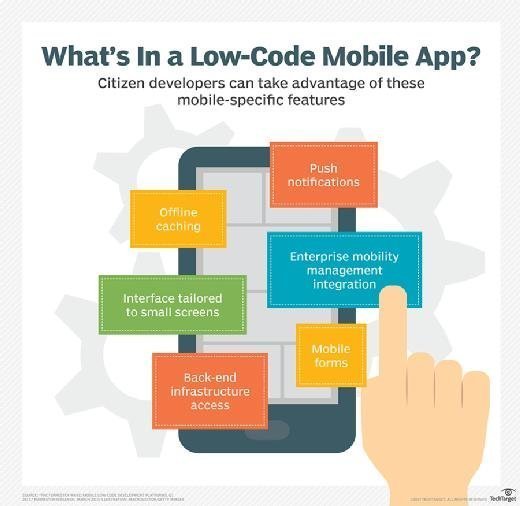Handy Facts To Choosing Legacy application modernization with Low-code
Wiki Article
The Accessibility Of Low-Code Applications Is One Of The Main Benefits.
The following key factors make low-code programming accessible to those who are not developers.
Drag-and-Drop Builders: Low-code systems offer drag-and-drop interfaces which allow non-developers to create applications visually without writing code. Development is now more accessible for those with no technical background.
WYSIWYG editors The WYSIWYG editors "What You See Is What You get" editors allow users to design workflows and interfaces that are identical to the finished product. This makes it much easier to use and understand.
Simplified Logic and Workflow Design:
Visual Workflow modeling: Users design business processes and application logic with visual flowcharts. The models are more intuitive to use than traditional codes.
Pre-built Components of Logic Low-code platforms typically include pre-built logic (e.g. loops, conditional statement) that can easily be set up, eliminating the need for complex programming.
Reusable Components and Templates
Libraries of pre-built templates: A lot of low-code platforms provide templates for common application types that allow non-programmers to begin with a solid foundation and alter as required.
Reusable Widgets and Modules Users can make use of reusable widgets and modules, streamlining the creation process and eliminating the need for technical expertise.
Tutorials and Guided Development
Step-by-Step guides: Platforms provide tutorials and online assistance for non-developers building applications.
Interactive Tutorials - Interactive tutorials which let you interact with the platform will assist you in learning and build confidence.
Integration with tools already in use:
Easy Integration: Low-code platforms are designed to be easily integrated with the existing business tools and systems (e.g., CRM, ERP), allowing non-developers to develop applications that function within their current workflows.
APIs/Connectors: The built-in APIs/connectors allow non-developers to connect their apps to other services.
Collaboration Features:
Team Collaboration real-time collaboration, shared workspaces, and shared workspaces enable business analysts, non-developers, and other stakeholder groups to effectively work alongside professional developers.
Access control based on role: Role levels are able to be set for people who aren't developers to ensure they can still contribute to the development process, but without compromising security.
Automated Testing & Debugging
Low-code platforms often come with integrated testing and debugging tools that makes this process easier. Non-developers can now easily verify that their app is working correctly.
Platform highlights errors when they occur and offers fixes. This helps non-developers with solving problems.
The capacity of low-code software to facilitate development to non-developers is their biggest benefit. Low-code platforms allow businesses to take part in the creation and maintenance of apps by offering visual tools and guided experience. This helps bridge the gap between technical implementation and business needs. Read the recommended Low-code Platform for application development tips for blog info including stored sql procedures, rapid applications, azure sql databases, developing mobile apps, app modernisation, no code platforms, develop mobile application, app platforms, rapid application design, low code platforms and more.

Benefits Of Low-Code Application Development In Terms Of Scalability And Flexible
Low-code application development offers a variety of advantages, including scalability and flexibility in design of the application. These are essential to create applications that respond to changing requirements and grow with the business. Here are a few main benefits: Rapid scaling:
Cloud-Based deployment: Many lowcode platforms are based on the cloud, allowing applications to scale up with the infrastructure. This allows businesses to handle more workloads without having to worry about the management of servers.
Auto-Scaling: The auto-scaling function allows you to automatically adjust resources in accordance with the demands. This ensures the same performance even during peak hours, without any manual intervention.
Flexible Architecture:
Modular Design: Low-code platforms promote modular application design, which means that components can be developed independently, tested, and scaled. Modularity is an excellent way to enhance flexibility. It is also easy to modify and expand the functionality of a system without having the entire application affected.
Microservices Architecture: Microservices architecture allows the creation of applications as a loosely coupled collection of services. This improves the flexibility and scalability.
Customizable Options:
Extensibility. Low-code platforms typically allow for custom coding or scripting. This allows developers to expand the functionality of the application beyond what it comes with out of the package. This guarantees that specific business requirements can be met without constraints.
Third-Party Integrations: The capacity to connect with third-party services and APIs permits businesses to incorporate additional functionalities and services as needed and enhance the capabilities of the application.
Agile Development Deployment, Agile Development Agile Development:
Continuous Delivery and Deployment: Low-code platforms are able to support agile methodologies which allow continuous integration as well as continuous delivery (CI/CD). This allows applications to be updated and upgraded swiftly, in response with feedback from users.
Iterative Design: Since low-code is an iterative procedure it is possible to gradually improved and enlarged. This allows for gradual growth and decreases the risk of large-scale changes.
Resource Optimization
Effective Resource Management Low Code platforms optimize the use of resources through tools that monitor and manage the performance of a program. It ensures that resources are utilized effectively and efficiently can be scaled up or down depending on actual requirements.
Load Balancing: The integrated load balancing functions distribute the workload equally across servers, increasing the application's ability to handle heavy traffic and ensuring consistent performance.
Global Reach
Multi-Region availability: Lowcode platforms permit the deployment of applications across different regions. Businesses can offer users high-speed, low-latency global access. This is particularly important for applications that have an international user base.
Localization: Support for localization is built in, which allows applications to be easily adjusted for different languages or regional demands. This increases flexibility for various markets.
Maintenance and Updates
Simplified maintenance: The visual and module nature of low code applications simplifies the maintenance tasks. They allow upgrades and bug fixes to be made quickly without lengthy downtime.
Version Control: The integrated system for controlling version allows the safe release of rollbacks and updates. Versions from the past can be restored in the event that they're required.
Cost Efficiency:
Lower development costs: Low-code systems enable a reduction of the development costs by removing the need to code in depth. This allows applications to be expanded without a significant increase of development effort or expense.
Pay-As You-Go Models - Many low-code applications have flexible pricing models, such as pay-as you-go that aligns costs with the actual usage, growth, and financial flexibility.
The majority of low-code app developers provide a lot of flexibility and scalability that lets businesses quickly create adaptable and flexible applications. These platforms can quickly adapt to changes in demand and efficiently use resources, and continually improve, allowing apps and companies alike to grow and expand. Read the best Legacy application modernization with Low-code blog for more info including ms azure sql, software for app development, cloud software applications, rapid app development, push notifications android, jdbc server, no code platforms, azure sql server, push notifications android, mobile development platforms and more.

Benefits Of Low-Code Application Development In Terms Of Collaboration And Workflow
Low-code app development is an excellent option for companies looking to increase team efficiency by streamlining the development process. Here are the key advantages: Improved Cross-Functional Collaboration:
Unified Development Environment. Low-code platforms let all team members collaborate in a single, integrated environment. This includes business analysts, developers and designers as well as stakeholder. This helps eliminate silos and encourages greater communication.
Visual Development Tools: The visual drag-and-drop feature of low-code platforms makes it easy for non-technical team members participate in the process of development, while ensuring that the requirements of the business are correctly captured and implemented.
Enhanced Communication:
Real-Time Collaboration Many low-code platforms have real-time features such as commenting and editing simultaneously, or instant feedback. This enables continuous communication, and helps to reduce the amount of time spent in back-and forth discussions.
Shared workspaces. Teams are able to collaborate through shared workspaces. There, they are able to see, edit, and discuss various project components.
Workflow management streamlined:
Integrated Project Management Tools: Many low-code platforms come with integrated tools for managing projects that help teams monitor and manage their projects for development. This includes task assignment, progress tracking, and deadline management.
Workflow Automation Automating repetitive tasks and workflows can help reduce manual mistakes and work which allows the team to concentrate on strategic activities while improving efficiency.
Speedier Iteration cycles
Rapid Prototyping Low-code platforms are ideal for quick prototyping. Iterative development is also feasible and allows teams to develop, test and refine their software in shorter times. This means feedback can be quickly integrated and improvements are made.
Support for Agile Development: Using agile practices allow teams to collaborate continuously during sprints. This makes it easier to adjust and provide small incremental improvements to capabilities.
Accessibility for non-developers
Citizen Development: Low-code platforms let business users (citizens developers) to build and modify their applications without having a deep understanding of programming. This relieves IT and Development teams of the burden and allows faster responses to the business demands.
Training and Onboarding: Easy interfaces and comprehensive training materials make it simpler for new team members to learn the ropes, enhancing the overall collaboration within the team.
Centralized Documentation, Knowledge Sharing and Information Sharing
Documentation is integrated: Low code platforms often come with the tools needed to create and manage documentation within the platform, making it simple for all project details to be centralized.
Knowledge Repositories: Teams are able to develop and maintain knowledge repositories that include the best practices, templates and reuseable components, helping to facilitate sharing of knowledge and reducing the duplication of effort.
Consistency and Standardization
Standardized components: Standardized components that are pre-built ensure consistency in applications. Team members can comprehend and work more easily on different parts.
Governance and Compliance: Built-in frameworks for governance ensure that each development adheres to the organizational guidelines and regulations which reduces the possibility of non-compliance as well as ensuring that applications meet quality standards.
Feedback Loops and Improvement Loops
Integrated Feedback mechanisms: Low-code platform usually have an integrated feedback mechanisms, which allow users to provide feedback to applications. Feedback can then become incorporated into development.
Continuous Improvements: The ability for applications to quickly iterate and then implement changes in light of feedback, while ensuring they are in tune to the needs of the user and business goals.
Visualization & Reporting
Real-time Analytics: Built-in analytics and reports provide real-time insights into the project's performance, user interaction and development. Decision-making based on data is possible.
Visual Workflow Mapping: Visual tools that create workflow maps can be used by teams to improve workflows. This can help them pinpoint the bottlenecks, as well as areas to improve.
Low-code application development can be a very effective tool for collaboration and workflow. It connects different teams, improves communication, and helps automate processes. This results in a more flexible, collaborative and efficient development environment that leads to more efficient and high-quality applications.
